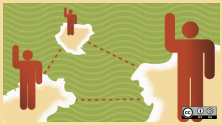As the internet opens the planet into a world stage, inclusion should be at the forefront of how we design, build, and implement our ideas. With 15% of people self-identifying as disabled worldwide, that is far too many people to leave behind due to lack of accessibility. This includes permanent, temporary, episodic, and situational disabilities.
In 2022, we published some great articles about making digital assets more accessible. Here are a few of the top picks.
Accessibility settings in open source tools
In How I use Linux accessibility settings, Don Watkins outlines a few ways different Linux distros support settings for vision, hearing, and typing. There are also links to Linux distributions that meet some specific needs of users.
Another article by Don Watkins, 5 ways LibreOffice supports accessibility, reviews a few accessibility features in LibreOffice that increase usability for everyone. Included in the article are common shortcuts you can learn and how to use the tools without a mouse. There is also a section that outlines more accessibility settings using the tool menu.
Open source screenreaders and voice to text
DeepSpeech is a voice-to-text command and library for developers who want to add voice input to their applications. It can also benefit people who live with low vision, limited mobility, and situational disabilities that keep their hands busy. Use Mozilla DeepSpeech to enable speech to text in your application by Seth Kenlon goes into how to download and install this tool. It also gives some pragmatic examples of how the tool can be used.
Use this open source screen reader on Windows really goes into detail about how to use the NVDA screen reader. Peter Cheer moves from why he likes this particular screen reader to how to install the software. Because NVDA is free and open source, it is an excellent tool for testing website accessibility once you have full command of how a native user might use it.
Vojtech Polasek is a blind software engineer focusing on computer security and accessibility for blind users. In his article, Remixing Linux for blind and visually impaired users, Vojtech writes about his challenges accessing digital assets and outlines his assistive technology stack. Since he is a Linux user, he set out with his team to develop the Vojtux project, a remix of Fedora that increases usability for visually impaired and blind users.
Accessibility for the future
It is amazing how far along technology has come over the years to provide software that allows for equal accessibility. One can only hope that tech will continue improving in this direction. Keep an eye out for more articles about this very topic on Opensource.com!







Comments are closed.